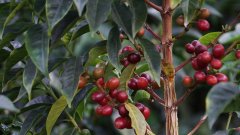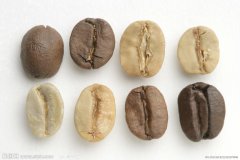To buy coffee beans online, you must know how to buy coffee beans.
2016, we advocate the slogan "Coffee for all". In other words, coffee has been or is coming into people's daily life and should become a basic physiological, convenient and daily consumption drink.
Online shopping is hard to tell the true from the false! Especially as a kind of food and drink, it is directly related to the health of consumers. How to correctly choose a healthy and fresh coffee is a problem faced by many coffee lovers. To this end, we summarize three categories and will explain them in detail for you:
1. On the shelf life of ripe coffee beans
2, about the so-called "steaming drum bag" in the previous paragraph of hand flushing.
3. About the color difference of coffee cooked beans.

(the picture is from the Internet)
On the shelf life of ripe coffee beans
The shelf life of ripe coffee beans is not only an old topic, but also an important topic that can not be avoided. What "quality" does the "shelf life" of ripe coffee beans guarantee? The coffee is also flavored. If the flavor is seriously deteriorated, the "quality" will no longer exist, and even though the coffee can still be drunk, its core value no longer exists. Therefore, we think that the shelf life of ripe coffee beans can also be regarded as a "taste period". Next, it is necessary for us to review and expand some of the contents of "Coffee Coffee" and answer them through three conclusions.
The first conclusion: after the raw coffee beans are roasted into cooked beans, the texture becomes loose and fragile, the whole body is covered with holes, has the structural characteristics similar to honeycomb, the contact area with air increases greatly, the oxidation rate is accelerated, the aromatic substances dissolved in carbon dioxide continue to escape, and the smell around them will be absorbed as strongly as activated carbon, for ordinary consumers like us who do not master high-tech means. Once the coffee beans are out of the pot, it means that there is an unstoppable process of flavor deterioration, and any packaging and preservation means we do are only to delay the process of flavor deterioration, but it is impossible to prevent it. The sooner you get rid of the ripe coffee beans in your hand, the fresher and more cost-effective the coffee beans you drink. The reason is that simple.
The second conclusion is about the fresh cycle of coffee and ripe beans. The fresh cycle of ripe coffee beans mentioned in Coffee Coffee is a "qualitative description" for coffee lovers from zero starting point, which is suitable for ordinary coffee consumers, rather than quantitative scientific conclusions in the laboratory. Without considering the special season, temperature, humidity, air pressure, different roasting degree of coffee beans and the design of baking curve, 20 ℃ ideal, coffee lovers can evaluate freshly roasted coffee beans according to the following ideas. Bean cultivation period: freshly roasted coffee beans (after thoroughly cooling) should be stored in a bag with an one-way exhaust valve as soon as possible. At this time, although the freshness is the highest, but the texture is not stable, at this time brewing is also easy to taste some unpleasant taste of tobacco. This process is commonly known as "raising beans", and 1-2 days is the shortest period for raising beans. Of course, the coffee beans extracted by trickle filtration are somewhat different from the ones used to make Espresso. The latest fresh period: calculated from the end of the bean cultivation period, if it is well preserved, this stage lasts about 2 weeks. We might as well call it the "latest fresh period". Fresh period: from the end of the "fresh period" of about 2 weeks, the coffee beans in the bag gradually go down from the peak state. However, if it is properly preserved, the quality and flavor of coffee beans decline slowly in the first period of time, and the freshness of coffee beans is still at a high level. We call it a "relatively fresh period" for about one month. Every coffee lover and coffee shopkeeper should strive to use up the coffee beans purchased before the end of the "fresh period". Disposal period: calculated from the end of the "fresher period" of about 4 weeks, the quality and flavor of ripe coffee beans has been much worse than before, it is difficult to act as the word "fresh", unable to meet the picky needs of professionals. However, it is OK to make some fancy coffee, such as refreshing coffee for family breakfast, black coffee for coffee shops, or blending milk, cream, chocolate sauce, etc., which need not be denied at all. We believe that this stage can be maintained for about a month, during which time we need to open the bag and use it as soon as possible, which can be called the "disposal period". From the latest fresh period everywhere, a total of about 10 weeks, neither long nor short, might as well be regarded as the "taste period" of coffee and ripe beans.
The third conclusion: the changes of external temperature, humidity, light, pressure and other factors will affect the preservation of coffee cooked beans, and most of them will accelerate the deterioration of coffee cooked beans. We should pay special attention to the daily coffee consumption.

(the picture is from the Internet)
About the so-called "stewed drum buns" in the previous paragraph.
There are still many students or customers obsessed with the so-called "braised drum bag" when making the front paragraph by hand, and habitually equate "obvious big drum bag" with "fresh coffee". I have to write an article here to explain it. Many coffee books, textbooks or professors will mention a similar sentence: "freshly roasted coffee beans will be hand-flushed after grinding, and the coffee powder layer will form obvious bulging bags due to exhaust expansion." however, it is not wrong to omit many prerequisites, and it is very inappropriate to list them separately as a technical standard for judging the quality of coffee beans.
First of all, we should know that at this time, the gas from the expansion is mainly carbon dioxide accumulated in coffee beans (proteins and other substances make up the shell of bubbles), then the amount of carbon dioxide is obviously closely related to the amount of exhaust. So let's see, in addition to the freshness of roasted coffee beans, what other factors also affect the accumulation of carbon dioxide in ripe coffee beans, thus affecting the so-called "stewed drum buns" we see.
The first factor: the roasting degree of coffee beans. For the same type of coffee beans, the braised drum bags formed by light roasting are obviously not as obvious as those formed by medium roasting. Therefore, when you buy lightly roasted coffee beans (especially Yega Xuefei, etc.), please don't expect a very obvious "bulging drum".
The second factor: the grinding thickness of coffee beans. We will find that during rough grinding, the coffee powder layer is difficult to form an obvious "bulging drum", the specific reason is self-evident, do not repeat.
The third factor: the temperature of brewing water. It is not difficult to find this: when we brew with lower water temperature, the "bulging drum" of the powder layer is difficult to appear.
The fourth factor: the interval between grinding and water injection. When many coffee lovers are making coffee by hand, after grinding, they often find that they have forgotten to boil water, or other preparations have not been done, so they rush to work together, put the coffee powder aside, and then come back to inject water after a period of time. Do not realize that this seemingly inconspicuous period of time, coffee powder is crazy oxidation and exhaust, want to count on the powder layer of the "bulging bag" is not easy.
In fact, there are many factors that will also affect the so-called "braised drum bag" in the previous paragraph, such as coffee bean bags containing activated carbon bags that absorb peculiar smell, such as grinding and drying with a sieve to remove fine powder. for example, coffee roasters take some special baking curves to deal with, in a word, there are many possibilities, which are inexplicable. As soon as I saw that there was no obvious so-called "steamed drum bag" in the front paragraph, I arbitrarily judged that the coffee beans were not fresh, and then criticized them verbally, which was really unfair, and I didn't understand the embodiment of coffee. I hope my friends would know.

Important Notice :
前街咖啡 FrontStreet Coffee has moved to new addredd:
FrontStreet Coffee Address: 315,Donghua East Road,GuangZhou
Tel:020 38364473
- Prev

Do you know the variety of Kaduai coffee?
Catuai Kaduai (Kaduai) is an artificial hybrid of Caturra Kaddura and Mondu Novo New World coffee. Kaduai has a good ability to resist natural disasters, especially wind and rain. Catuai Kaduai (Kaduai) is cultivated in Brazil and is now widely grown in Central America. This kind of coffee: Costa Rican Bayer-Los Santos, Sal
- Next

On the Color difference of cooked Coffee beans Coffee beans are different in color
Occasionally received customer complaints, reflecting the color of coffee beans there is a color difference, as well as a little different sizes, and thus question the quality of coffee beans. We are very distressed by comparison. China's coffee consumption market has just started, and then Xiaobai's problems must be explained repeatedly. I am really tired and helpless. First of all, let's think about it: who will be there when eating in a restaurant?
Related
- Beginners will see the "Coffee pull flower" guide!
- What is the difference between ice blog purified milk and ordinary milk coffee?
- Why is the Philippines the largest producer of crops in Liberia?
- For coffee extraction, should the fine powder be retained?
- How does extracted espresso fill pressed powder? How much strength does it take to press the powder?
- How to make jasmine cold extract coffee? Is the jasmine + latte good?
- Will this little toy really make the coffee taste better? How does Lily Drip affect coffee extraction?
- Will the action of slapping the filter cup also affect coffee extraction?
- What's the difference between powder-to-water ratio and powder-to-liquid ratio?
- What is the Ethiopian local species? What does it have to do with Heirloom native species?

